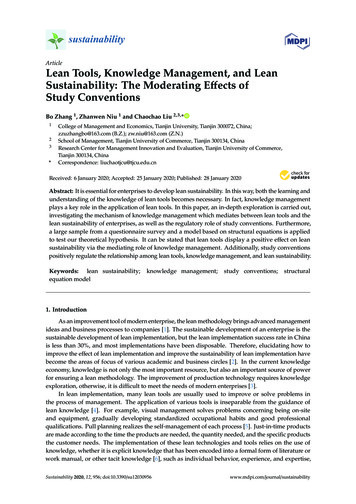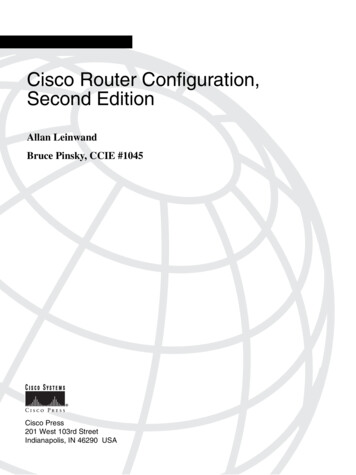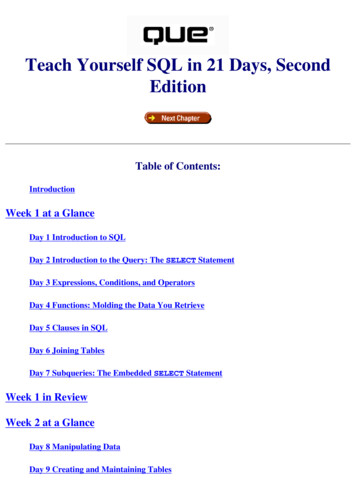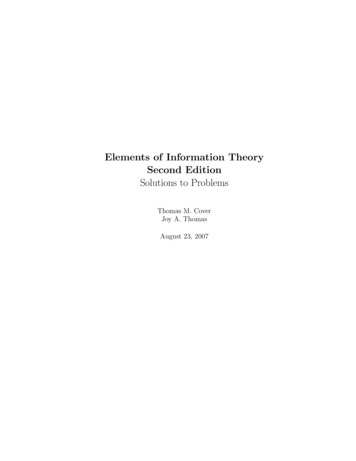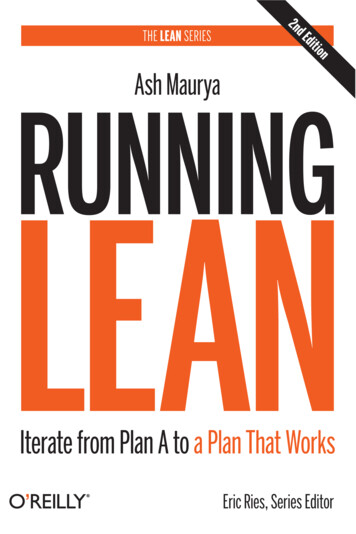
Transcription
Praise for Running Lean, Second Edition“Easily one of the best technical books on Lean Startup ever written.Period. End of point. Done.”Dan MartellFounder, Clarity.fmAngel Investor“In Running Lean, Ash has put together a book I wish I’d read beforepursuing my own startup. The Lean methodology has received a lotof press, but the level of detail, including case studies and practicalapplications, make this book a resource worthy of sitting on every aspiringentrepreneur’s shelf. It’s not just great advice, but a great read, too.”Rand FishkinCEO and Cofounder, SEOmozCoauthor, The Art of SEO“Customer validation has always been one of the best ways to eliminatewasted effort and shortcut directly to what will work. Eric Ries and SteveBlank did the startup world a great service by codifying and labeling theprinciples involved. Ash Maurya goes one step further, providing a clearroadmap for Internet entrepreneurs, with a delightfully clear andsimple writing style.”David SkokAuthor, For Entrepreneurs BlogGeneral Partner, Matrix Partners“Ash provides compelling, actionable guidance for applying Leanprinciples to a startup. His startup canvas changed the way I think aboutmy own startup. This book is a valuable guide whether you are a serialentrepreneur or a first-time founder.”Sean EllisFounder and CEO, CatchFree
“Lean concepts are exciting, but it’s hard to know what to actuallydo. Ash not only gives advice, he makes it practicable—this is the firstcomprehensive guidebook for how to execute a Lean Startup.”Jason CohenFounder, WP Engine and Smart Bear“Ash has laid out a clear compass for anyone to validate their ideas, solvereal problems, and create a successful business. I’d recommend this book toanyone trying to get a business off the ground.”Noah KaganChief Sumo, AppSumo.com“You’ve read the theory—now Ash distills it to practice. Running Leanis a straightforward toolkit that distills wisdom from the startup world’sgreatest minds into battle-tested, actionable steps.”Dan ShapiroCEO and Founder, Sparkbuy and Ontela“I wish I had read Ash’s book before setting out on my own entrepreneurialjourney, as it lays out clearly and concisely a cheat sheet to learn many ofthe lessons that I’ve learned in the last four years through the school ofhard knocks.”Jason JacobsFounder and CEO, RunKeeper“Running Lean is remarkably relevant and clarifying for today’s generationof Internet entrepreneurs, and it’s applicable to so much more. Ash outlinesa way of thinking, testing, and launching that can and should be applied tovarious organizations (small to big), functions (engineering to marketing),and models (consumer to enterprise).”Ryan SpoonInvestor, Polaris Venture PartnersAuthor, RyanSpoon.com
“In Running Lean, Ash Maurya lays out a clear, practical plan for givingyour startup the best possible chance. We used his approach at Year OneLabs with every one of our startups. It’s the best way for new companies tofind their groove, explain their business model, and ultimately,grow their business.”Alistair CrollFounding Partner, Year One LabsSolve for Interesting“The ‘Missing Manual’ for startups. The advisory team at MaRS uses thetools in Running Lean every day. Over the last year, we’ve tested them withdozens of startups and found them invaluable in moving entrepreneursfrom idea to product/market fit efficiently.”Mark ZimmermanSenior Advisor, MaRS“Running Lean is a terrific step-by-step guide combining the best ofLean Startup, customer development, business model canvas, and agile/continuous integration. Anyone involved in starting, funding, or helpingothers build new businesses will benefit, as our students at Northwesternhave, from this practical and comprehensive guide to the modern startup.”Todd WarrenDivergent VenturesClass Chairman, NUvention Web, Northwestern University“This is an invaluable resource for budding entrepreneurs, providing a wealthof immediately actionable advice within a logical and accessible framework.”Dave ChapmanVice-Dean for Enterprise, Faculty of Engineering SciencesDeputy Head of Department, Science & InnovationDirector MSc Technology EntrepreneurshipUniversity College London
“Running Lean is THE practical guide for understanding and implementingLean Startup. It’s clear, well-organized, and detailed. Ash doesn’t guaranteesuccess, or claim Lean is perfect (it’s not!), but he’ll help you avoid themost common and painful pitfalls of running a startup. If you want tobe systematic, rigorous, and honest in your startup efforts, as opposed tothrowing a Hail Mary pass while blindfolded in space, read anduse Running Lean.”Benjamin YoskovitzVP Product, GoInstantFounding Partner, Year One Labsinstigatorblog.com“Running Lean was a good overview of the Lean Startup principles aspractically applied to software/Internet startups. Virtually everyonein the space, including those very familiar with other writing on theLean Startup, can pull at least one useful tactic out of it. Iparticularly liked the discussion of how to use customer developmentinterviews to overcome pricing objections.”Patrick McKenzieFounder, Kalzumeus Software@patio11“Running Lean is a great resource for the aspiring or successful webentrepreneur since it consolidates the best startup thinking in a practicalguidebook that will prevent you from making the some of the mostcommon early-stage mistakes. It is required reading for all mystudents and angel investment management teams since itimproves the chance of startup success.”Michael MarascoDirector and Professor, Farley Center for Entrepreneurshipand Innovation, Northwestern UniversityAngel Investor
“Running Lean is the Missing Manual to the Lean Methodology thatfocuses on actionable tactics to help you find and vet your web startup idea.If you’re considering building an application using the Lean methodology,you are wasting valuable time by not following the path Ash has laid out inthis book.”Rob WallingSerial EntrepreneurAuthor, Start Small, Stay Small: A Developer’s Guide to Launching a Startup
Running LeanSecond EditionIterate from Plan A to aPlan That WorksAsh MauryaBeijing· Cambridge · Farnham · Köln · Sebastopol · Tokyo
Running Lean, Second Editionby Ash MauryaCopyright 2012 Ash Maurya. All rights reserved.Printed in the United States of America.Published by O’Reilly Media, Inc., 1005 Gravenstein Highway North, Sebastopol, CA95472.O’Reilly books may be purchased for educational, business, or sales promotional use.Online editions are also available for most titles (http://my.safaribooksonline.com). Formore information, contact our corporate/institutional sales department: (800) 998-9938or corporate@oreilly.com.Editor: Mary TreselerProduction Editor: Holly BauerCopyeditor: Audrey DoyleProofreader: Kiel Van HornIndexer: Ellen Troutman ZaigProduction Services: Octal Publishing, Inc.Cover Designer: Mark PagliettiInterior Designer: Ron BilodeauIllustrators: Robert Romano,Rebecca Demarest, and Emiliano VillarrealFebruary 2011: First Edition.February 2012: Second Edition.Revision History for the Second Edition:2012-02-07First releaseSee http://oreilly.com/catalog/errata.csp?isbn 0636920020141 for release details.Nutshell Handbook, the Nutshell Handbook logo, and the O’Reilly logo are registeredtrademarks of O’Reilly Media, Inc. Running Lean and related trade dress are trademarks of O’Reilly Media, Inc.Many of the designations used by manufacturers and sellers to distinguish theirproducts are claimed as trademarks. Where those designations appear in this book,and O’Reilly Media, Inc., was aware of a trademark claim, the designations have beenprinted in caps or initial caps.Although the publisher and author have used reasonable care in preparing this book,the information it contains is distributed “as is” and without warranties of any kind.This book is not intended as legal or financial advice, and not all of the recommendations may be suitable for your situation. Professional legal and financial advisorsshould be consulted, as needed. Neither the publisher nor the author shall be liable forany costs, expenses, or damages resulting from use of or reliance on the informationcontained in this book.ISBN: 978-1-449-30517-8[CW]
For Natalia and Ian, who gave me a new appreciationfor our scarcest resource—time
ContentsForeword . . . . . . . . . . . . . . . . . . . . . . . . . . . . . XIIIPreface . . . . . . . . . . . . . . . . . . . . . . . . . . . . . XVIIIntroduction . . . . . . . . . . . . . . . . . . . . . . . . . . XXIPART 1: ROADMAPChapter 1Meta-Principles . . . . . . . . . . . . . . . . . . . . . . . . . . 3Chapter 2Running Lean Illustrated . . . . . . . . . . . . . . . . . . . 15PART 2: DOCUMENT YOUR PLAN AChapter 3Create Your Lean Canvas . . . . . . . . . . . . . . . . . . . 23PART 3: IDENTIFY THE RISKIEST PARTS OF YOUR PLANChapter 4Prioritize Where to Start . . . . . . . . . . . . . . . . . . . 49Chapter 5Get Ready to Experiment . . . . . . . . . . . . . . . . . . 57XI
PART 4: SYSTEMATICALLY TEST YOUR PLANSTAGE ONE: Understand ProblemChapter 6Get Ready to Interview Customers . . . . . . . . . . . . 71Chapter 7The Problem Interview . . . . . . . . . . . . . . . . . . . . 81STAGE TWO: Define SolutionChapter 8The Solution Interview . . . . . . . . . . . . . . . . . . . . 95Chapter 9Get to Release 1.0 . . . . . . . . . . . . . . . . . . . . . . 111STAGE THREE: Validate QualitativelyChapter 10Get Ready to Measure . . . . . . . . . . . . . . . . . . . 121Chapter 11The MVP Interview. . . . . . . . . . . . . . . . . . . . . . 127Chapter 12Validate Customer Lifecycle . . . . . . . . . . . . . . . . 135STAGE FOUR: Verify QuantitativelyChapter 13Don’t Be a Feature Pusher . . . . . . . . . . . . . . . . . 145Chapter 14Measure Product/Market Fit . . . . . . . . . . . . . . . 155Chapter 15Conclusion . . . . . . . . . . . . . . . . . . . . . . . . . . . 169AppendixBonus Material . . . . . . . . . . . . . . . . . . . . . . . . 173Index . . . . . . . . . . . . . . . . . . . . . . . . . . . . . . 197XIICONTENTS
ForewordRunning Lean is the first book in the new Lean Series. Following thepublication of The Lean Startup last year, I have had the opportunity tomeet thousands of entrepreneurs and managers around the world. I haveenjoyed hearing their stories and grappling with their questions. Most ofall, I have heard an overwhelming demand for practical guidance for howto put Lean Startup principles into practice. There is no better person tobegin that mission than Ash Maurya.“Practice trumps theory.” When I first read those words on Ash Maurya’sblog, I knew he would be a valuable addition to a fledgling movement thatwas just getting started. Since then, he has been a tireless advocate for theLean Startup movement. He has rigorously tested techniques for applyingthese ideas in his own startups, sharing what works and what doesn’t. He hasconducted countless workshops, each of which is a crucible for discoveringthe challenges that real entrepreneurs face and for evaluating which solutionsreally work. And he has been a leader in bringing the movement to hishometown of Austin, one of our most important startup hubs.The result of all of this work is the volume you now hold in your hand.Running Lean is a handbook for practicing entrepreneurs who want toincrease their odds of success. This is not a book of philosophy, or anentertaining compendium of anecdotes. Rather, it is a detailed look at abattle-tested approach to building companies that matter.XIII
We are living in an age of entrepreneurship. Most of the net new jobgrowth in the USA in the past few decades has come from high-growthstartups. All of us—investors, managers, policy makers, and ordinarycitizens—have an interest in creating the conditions that will fosterentrepreneurship. Our future prosperity depends on it.There are probably more entrepreneurs operating today than at any timein history, thanks to profound changes in the startup landscape. Newtechnologies, like cloud computing, are making it easier and cheaper toget started. New management methods, like the Lean Startup, are helpingfounders make better use of these capabilities. There has never been a bettertime to be an entrepreneur.If I had to summarize these changes in one phrase, it would be this one:“the rentership of the means of production”—turning Karl Marx’s famousdictum on its head. In past eras, to build and operate a company of significantscale required dozens of stakeholders to give you permission. You neededaccess to capital, machinery, factories, warehouses, distribution partners,mass-market advertising, and so on.Today, anyone with a credit card can rent all of these capabilities andmore. What is significant about this development is that it enables morestartup experiments than ever before. And make no mistake, a startup isan experiment. Today’s companies can build anything they can imagine. Sothe question we are called on to answer is no longer primarily, “can it bebuilt?”, but rather, “should it be built?”We need these experiments more than ever. The old management tools,pioneered by 20th-century companies like General Motors, relied onplanning and forecasting in order to measure progress, assess opportunities,and hold managers accountable. And yet who really feels that our world isgetting more and more stable every day?Successful new products require constant, disciplined, experimentation—inthe scientific sense—in order to discover new sources of profitable growth.This is true for the tiniest startup as well as for the most establishedcompany.XIVFOREWORD
Running Lean provides a step-by-step blueprint to put these ideas intoaction. A business plan rests on a series of leap-of-faith assumptions,each of which can be tested empirically. Will customers want the productwe’re building? Will they pay for it? Can we provide a service profitably?And once we find customers, can we grow? Running Lean lays out Ash’sapproach to breaking these assumptions down so that they can become thesubjects of rigorous experiments.Running Lean’s simple, action-oriented templates provide tools thatstartups in all stages of development can use to help build breakthrough,disruptive new products and organizations.It’s been just about three years since I first wrote the phrase “lean startup”in a blog post that a few dozen people read. Since then, these ideas havegrown into a movement, embraced by thousands of entrepreneurs aroundthe world dedicated to making sure that new products and new startupssucceed. As you read through Running Lean, I hope you will put these ideasinto practice and join our community. Odds are there is a Lean StartupMeetup taking place in your city. A complete list of meetups and linksto other resources can be found at the official Lean Startup homepage:http://theleanstartup.com.Welcome to the cutting edge of entrepreneurial practice. I hope you’ll sharewhat you learn, what works and what doesn’t. Thank you for being part ofthis experiment.Eric RiesJanuary 20, 2012San Francisco, CAFOREWORDXV
PrefaceThe first edition of Running Lean (released as an ebook) was targeted primarily at people like me: technical founders building web-based products.I was running my first company and on my fifth product at the time. Ihad been inspired by Steve Blank’s book The Four Steps to the Epiphany(http://www.cafepress.com/kandsranch) and the early works on the LeanStartup methodology by Eric Ries.My goal with the ebook was to create an actionable guide for other entrepreneurs building web-based products. I wrote and self-published the ebookiteratively using the same methodology outlined in the ebook.However, once the ebook was published in January 2011, the audience forthe book grew beyond my prototypical early adopter, and I was repeatedlymet with two kinds of feedback:r “I can see how these techniques worked for your business, but theywon’t work for me because I am building X.”r “Even though I am building X, these techniques have greatly helped mybusiness with only slight modifications.”(Where X ranged from software to hardware, B2C to B2B, and high-techto low-tech.)I was curious and decided to explore further. In the past year, I have activelysought opportunities to expose and test these ideas with a wide range ofbusinesses by way of running workshops, taking on mentor positions atXVII
several accelerators, and working closely with other entrepreneurs. I stillremember being nervous the first time I delivered a workshop to a roomfull of biotech entrepreneurs. But each time, the results were positivelyencouraging.The second edition of Running Lean aims to synthesize my learning overthe past year and broaden the audience. Even though a lot of these ideascame out of the high-tech startup world, I believe the principles theyembody are universally applicable to any startup or product.This is reflected in a completely new layout for the book that delineatesmeta-principles from tactics.I have also replaced the Lean Canvas case study (which some people foundconfusing) with a more complete example that follows throughout the bookfrom ideation to exit. In addition, I’ve supplemented the text with severalother smaller case studies from a wide range of products that illustratethese principles at work.Finally, since I wrote the first version, Eric Ries has published his book,The Lean Startup (Crown Business). Along with being the authoritativeguide on Lean Startups, the book also introduces several new and powerful concepts like Innovation Accounting and Engines of Growth that I haveincorporated into this edition.Safari Books OnlineSafari Books Online is an on-demand digital library that lets you easilysearch over 7,500 technology and creative reference books and videos tofind the answers you need quickly.With a subscription, you can read any page and watch any video from ourlibrary online. Read books on your cell phone and mobile devices. Accessnew titles before they are available for print, and get exclusive access tomanuscripts in development and post feedback for the authors. Copy andpaste code samples, organize your favorites, download chapters, bookmarkkey sections, create notes, print out pages, and benefit from tons of othertime-saving features.O’Reilly Media has uploaded this book to the Safari Books Onlineservice. To have full digital access to this book and others on similar topics from O’Reilly and other publishers, sign up for free at http://my.safaribooksonline.com.XVIIIPREFACE
We’d Like to Hear from YouPlease address comments and questions concerning this book to thepublisher:O’Reilly Media, Inc.1005 Gravenstein Highway NorthSebastopol, CA 95472(800) 998-9938 (in the United States or Canada)(707) 829-0515 (international or local)(707) 829-0104 (fax)We have a web page for this book, where we list errata, examples, and anyadditional information. You can access this page oTo comment or ask technical questions about this book, send email to:bookquestions@oreilly.comFor more information about our books, courses, conferences, and news, seeour website at http://www.oreilly.com.Find us on Facebook: http://facebook.com/oreillyFollow us on Twitter: http://twitter.com/oreillymediaWatch us on YouTube: http://www.youtube.com/oreillymediaAttributions and PermissionsThis book is here to help you get your job done. If you reference limitedparts of it in your work or writings, we appreciate, but do not require,attribution. An attribution usually includes the title, author, publisher, andISBN. For example: “Running Lean, Second Edition (O’Reilly). Copyright2012 Ash Maurya, 978-1-449-30517-8.”If you feel your use of examples or quotations from this book falls outsidefair use or the permission given above, feel free to contact us at permissions@oreilly.com.PREFACEXIX
IntroductionWhat Is Running Lean?We live in an age of unparalleled opportunity for innovation. With theadvent of the Internet, cloud computing, and open source software, the costof building products is at an all-time low. Yet, the odds of building successful startups haven’t improved much.Most startups still fail.But the more interesting fact is that, of those startups that succeed, twothirds report having drastically changed their plans along the way.1So, what separates successful startups from unsuccessful ones is not necessarily the fact that successful startups began with a better initial plan (orPlan A), but rather that they find a plan that works before running out ofresources.Up until now, finding this better Plan B or C or Z has been based more ongut, intuition, and luck. There has been no systematic process for rigorouslystress-testing a Plan A.That is what Running Lean is about.Running Lean is a systematic process for iterating from Plan A to a planthat works, before running out of resources.Why Are Startups Hard?First, there is a misconception around how successful products get built.The media loves stories of visionaries who see the future and chart a perfectcourse to intersect it. The reality, however, rarely plays out quite as simply.Even the unveiling of the visionary computer, the iPad, in Steve Jobs’ words1 John Mullins and Randy Komisar, Getting to Plan B (Boston, MA: Harvard BusinessReview Press, 2009).INTRODUCTIONXXI
was years in the making, built on several incremental innovations (and failures) of software and hardware.Second, the classic product-centric approach front-loads some customerinvolvement during the requirements-gathering phase but leaves most ofthe customer validation until after the software is released. There is a large“middle” when the startup disengages from customers for weeks or monthswhile they build and test their solution. During this time, it’s quite possiblefor the startup to either build too much or be led astray from building whatcustomers want. This is the fundamental dilemma described by Steve Blankin The Four Steps to the Epiphany, in which he offers a process for buildinga continuous customer feedback loop throughout the product developmentcycle that he terms “Customer Development.”And finally, even though customers hold all the answers, you simply cannotask them what they want.If I had asked people what they wanted, they would have said fasterhorses.—Henry FordA lot of people cite the preceding quote and declare it hopeless to talkto customers. But hidden in this quote is a customer problem statement:had customers said “faster horses,” they would really have been askingfor something faster than their existing alternative, which happened to behorses.Given the right context, customers can clearly articulate their problems,but it’s your job to come up with the solution.It is not the customer’s job to know what they want.—Steve JobsIs There a Better Way?Running Lean provides a better, faster way to vet new product ideas andbuild successful products:r Running Lean is about speed, learning, and focus.r Running Lean is about testing a vision by measuring how customersbehave.r Running Lean is about engaging customers throughout the productdevelopment cycle.r Running Lean tackles both product and market validation in parallelusing short iterations.r Running Lean is a disciplined and rigorous process.XXIIINTRODUCTION
Running Lean references an array of methodologies and thinkers. Three ofthe most important follow.Customer DevelopmentCustomer Development is a term coined by Steve Blank and is used todescribe the parallel process of building a continuous feedback loop withcustomers throughout the product development cycle. It is defined in hisbook, The Four Steps to the Epiphany.The key takeaway from Customer Development can best be summed up as:Get out of the building.—Steve BlankMost of the answers lie outside the building—not on your computer, or inthe lab. You have to get out and directly engage customers.Lean StartupLean Startup is a term trademarked by Eric Ries and represents a synthesis of Customer Development, Agile Software Development methodologies,and Lean (as in the Toyota Production System) practices.The term Lean is often misunderstood as “being cheap.” While “beingLean” is fundamentally about eliminating waste or being efficient withresources, that interpretation is not completely misguided because moneyhappens to be one of those resources.However, in a Lean Startup, we strive to optimize utilization of our scarcest resource, which is time. Specifically, our objective is maximizing learning (about customers) per unit time.The key takeaway from Lean Startup can best be summed up around theconcept of using smaller, faster iterations for testing a vision.Startups that succeed are those that manage to iterate enough timesbefore running out of resources.—Eric RiesBootstrappingBootstrapping is more commonly understood as a collection of techniquesused to minimize the amount of external debt or funding needed frombanks or investors. To often, people confuse bootstrapping with self-funding.A stricter definition is funding with customer revenues.INTRODUCTIONXXIII
However, I subscribe to a much more philosophical definition of bootstrapping put forward by Bijoy Goswami:Right action, right time.Startups are inherently chaotic, but at any given point in time, there areonly a few key actions that matter. You need to just focus on those andignore the rest.What Will This Book Teach You?In this book, you’ll learn:r How to first find a problem worth solving, before defining a solutionr How to find early customersr When is the ideal time to raise fundingr How to test pricingr How to decide what goes into Release 1.0r How to build and measure what customers wantr How to maximize for speed, learning, and focusr What is product/market fitr How to iterate to product/market fitIs This Book for You?If you are an entrepreneur considering building a new product, or if youalready have a product and you want to raise your odds of making it successful, this book is for you.Running Lean is for:r Business managersr CEOsr Developers and programmers who are interested in becoming successfulentrepreneursr Bloggers, cofounders, small-business people, writers, musicians—anyone who’s creative and interested in starting a new business projectr Innovatorsr Startup foundersXXIVINTRODUCTION
How Is This Book Organized?This book is organized into four parts. The parts are meant to be read inorder, as they outline the chronological steps required to apply RunningLean to your product—from ideation to product/market fit. Even if youalready have a product launched, I recommend starting from the beginning.You will not have to spend as much time going through the stages, and thisexercise will help you baseline where you currently are and formulate yournext actions.Each part ends with gating criteria that will help you decide if you’re readyto move on to the next one.Part 1: RoadmapPart 1 provides an overall roadmap of the Running Lean process. Specifically, it describes the three core meta-principles that capture the essence ofRunning Lean and ends with a short case study that helps illustrate theseprinciples in action.The rest of the book covers each of the following meta-principles in detailin three parts.Part 2: Document Your Plan APart 2 walks through the process of documenting your initial vision (orPlan A) using a portable one-page format called Lean Canvas. Your LeanCanvas will serve as your product’s tactical map and blueprint.Part 3: Identify the Riskiest Parts of Your PlanPart 3 helps you identify which aspects of your plan to focus on first. It layssome groundwork on the different types of risks startups face, shows youhow to prioritize them, and prepares you to start the process of testing andexperimentation.Part 4: Systematically Test Your PlanPart 4 outlines the four-stage process for systematically stress testing yourinitial plan and shows you how to iterate from your Plan A to a Plan ThatWorks.INTRODUCTIONXXV
About MeI bootstrapped my most recent company, WiredReach, in 2002, and sold itin late 2010. Throughout that time, I built products in stealth, attemptedbuilding a platform, dabbled with open sourcing, practiced “release early,release often,” embraced “less is more,”2 and even tried “more is more.”The first realization early on was that building in stealth is a really badidea. There is a fear, especially common among first-time entrepreneurs,that their great idea will be stolen by someone else. The truth is twofold:first, most people are not able to visualize the potential of an idea at such anearly stage, and second (and more importantly), they won’t care.The second realization was that startups can consume years of your life. Istarted WiredReach with just a spark of an idea, and before I knew it, yearshad passed. While I’ve had varying levels of success with the products Ibuilt, I realized that I needed a better, faster way to vet new product ideas.Life’s too short to build something nobody wants.And finally, I learned that while listening to customers is important, youhave to know how to do it. I used a “release early, release often” methodology for one of my products, BoxCloud, and launched a fairly minimalfile-sharing product built on a new peer-to-web model we had developedin 2006. After we launched, we got covered by a few prominent blogs anddumped some serious cash into advertising on the DECK network (primarily targeted at designers and developers).We started getting a lot of feedback from users, but it was all over the place.We didn’t have a clear definition of our target customer and didn’t knowhow to prioritize this feedback. We started listening to the most popular(vocal) requests and ended up with a bloated application and lots of onetime-use features.Around that time, I ran into Steve Blank’s lectures on Customer Development, from which I followed the trail to Eric Ries’s early ideas of the LeanStartup. I had dreamt the big vision, rationalized it in my head, and built
Lean Startup, customer development, business model canvas, and agile/ continuous integration. Anyone involved in starting, funding, or helping others build new businesses will benefit, as our


